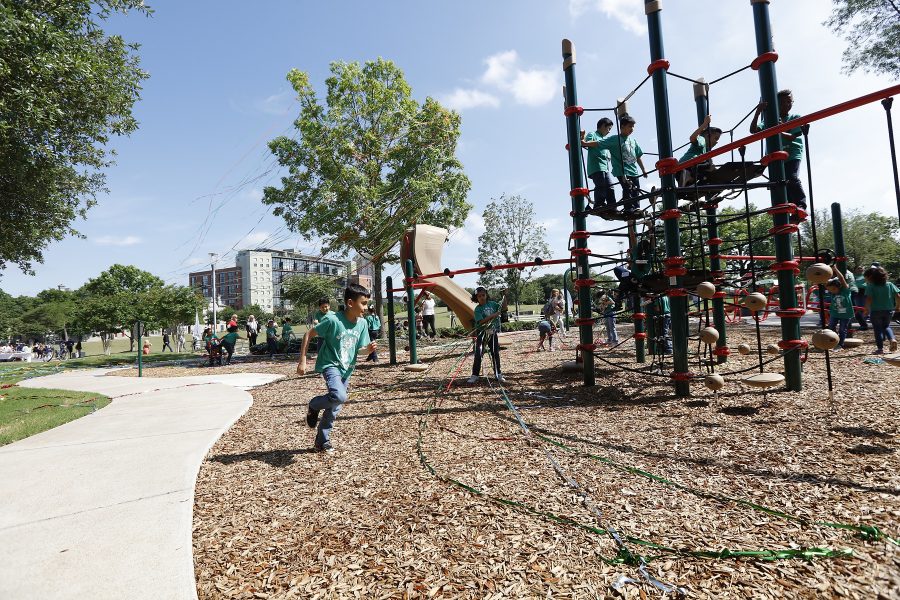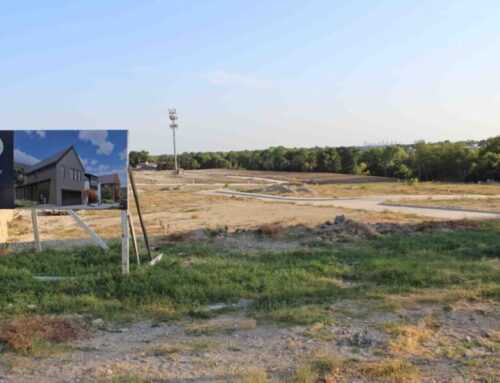
Photo courtesy of Uptown Dallas, Inc.
The front page of a recent Dallas Morning News “Real Estate Finder” advertising section, highlighting McMansions in Prosper and luxury patio homes in west Allen, had a sales pitch for college students and young professionals in Uptown, too:
Urban toddlers “make up Uptown’s fastest-growing demographic. … Couples get married and have children, but do not want to leave Uptown’s convenience and fun.”
In other words, come for the walkable nightlife; stay for the kid-friendly urban living.

Map courtesy of Uptown Dallas, Inc.
The story notes that 11 percent of the 19,200 residents in the square-mile Uptown Dallas, Inc. defines as Uptown are younger than 5, and nearly 20 percent are younger than 13. That means one in five residents of Uptown are children 12 and younger. A recent D Magazine column by Kourtny Garrett, president and CEO of Downtown Dallas, Inc., notes that in the Central Business District, “from 2000-2010, the number of children ages 0-4 grew by 55.6 percent [and] the projection for the next decade, from 2010-2020, predicts a similar trajectory at 45.7 percent growth.”
The prospect of living not just temporarily but also permanently in Uptown or Downtown is transitioning from wishful thinking to realistic planning. Yes, the new playground at Uptown’s Griggs Park that opened this spring was a welcome amenity for the neighborhood’s ever-expanding group of little ones, but swings and slides don’t address the main objection to an Uptown family life: schools.
“The challenge for many families is deciding where the children will attend school,” says the DMN Uptown real estate advertorial. “Where can I send my kids to school?” is the question Garrett asks, tries to answer, and notes that she frequently hears “not only from my downtown neighbors, but also from corporate decision-makers who are chasing the talent pool who craves urban living.” A January 2015 DMN story on families in Uptown notes that despite high growth in children ages 0-4, “the neighborhood has few school-age children — only about 1 percent of Uptown residents are between the ages of 5 and 17 … And there’s a sharp drop-off, from 10 percent to 1 percent, once children reach age 5. That indicates that people move out before kindergarten.”
Clearly, young families aren’t just leaving Uptown and Downtown for the front porches and backyards that beckon from single-family homes in Dallas and the suburbs; they’re leaving because they don’t think the schools are good enough for their children.
Dallas ISD has begun actively listening to such concerns in recent years as its student population dwindles. One change the district made was combining Uptown and Downtown residents into a single elementary school zone, Ben Milam Elementary, which is underutilized and populated mostly with students who transfer in.
“One of the goals of the Attendance Boundary Assessment Committee is keeping communities together — friends and neighbors, people they see at the Y and on the playground,” says Beth Weller, a committee member and DISD parent. The committee also recommended rezoning Milam students from Thomas Rusk Middle School to Alex Spence Middle School because “Spence had the space, and the thought was that Spence did have the talented and gifted [magnet] program, and the location was a little better for the families, so it might be more attractive for them to keep going through the system on up.”
The zoning change took effect in fall 2016, the same year DISD launched a dual-language immersion program at Milam, with native Spanish and English speakers in the same classroom, learning in both languages and from each other. That fall also saw the addition of pre-K for parents of 4-year-olds who didn’t qualify for state funding but wanted to pay tuition. DISD has seen success with both programs in attracting middle- and upper-income families to its schools.
Milam isn’t a low-performing school, according to state standards. Its high number of transfers — 229 of the 293 students at Milam during the 2016-2017 school year — indicate that families think highly of the school. However, almost 85 percent of Milam students live in poverty and 88 percent are Hispanic or black — demographics characteristic to most DISD schools but ones that tend to repel affluent, typically white families from such schools all over the district.
Attracting families to schools like Milam is not an overnight process. It takes years, something that Weller herself experienced when her children began attending DISD elementary schools years ago. She encourages parents of young ones to visit the school, get to know the principal and join forces.
“To me, the tipping number is 10,” Weller says. “If you can get 10 middle- to upper- income families who have more time and resources to invest in a school — form a PTA, set up some events — they’ll get the snowball rolling and can really make a difference.”
Last year, only 68 students zoned to Milam attended the school. Another 47 attended other DISD schools and 35 opted for charter schools. A whopping 398 students bypassed public school for private schools or homeschool. This means only 12 percent of students zoned to Milam attend the school, and 73 percent of them opt out of public school entirely.
Weller is optimistic about the reversal of that trend, however.
“There’s the new IDEA High School not far from that area, and the new CityLab High School is opening Downtown,” Weller says of two DISD “schools of choice” that admit students by lottery. “That may really revitalize Downtown as an educational center. Those families will have a lot of options.
“This way you’ve got more of a known quantity and you don’t think, ‘Well, I have to move out to Plano.’ ”







Leave A Comment